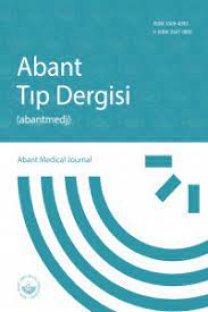Sınır ve Hafif Zeka Geriliklerinde Suç Türlerinin ve Cezai Sorumluluklarının Değerlendirilmesi: Herhangi Bir Fark Var Mıdır ?
Entelektüel bozukluk, zeka geriliği, suç, cezai sorumluluk
Assessing the type of offence and criminal responsibility in borderline and mild intellectual disabilities: Is there any difference?
___
- 1. American Psychiatric Association: Diagnostic and Statistical Manual of Mental Disorders, 4th ed. Washington, DC: American Psychiatric Press; 2004.
- 2. King BH, Kodapp RM, Bykens EM. Mental Retardation. In Kaplan&Sadock’s Comprehensive Textbook of Psychiatry. Sadock BJ, Sadock VA. (editors) 7st ed. Lippincott Williams&Wilkins 2000. p. 2587-2613. 3. Wettstein BM, Mulvey EP, Rogers R. A prospective comparison of four insanity defense standards. Am J Psychiatry 1991; 148 :21-7.
- 4. Katz N, Zemishlany Z. Criminal responsibility in Asperger's syndrome. Isr J Psychiatry Relat Sci 2006; 43: 166-73.
- 5. Männynsalo L, Putkonen H, Lindberg N, Kotilainen I. Forensic psychiatric perspective on criminality associated with intellectual disability: a nationwide register-based study. J Intellect Disabil Res 2009; 53: 279-88.
- 6. Holland AJ. Criminal behaviour and developmental disability: An epidemiological perspective. In Offenders with developmental disabilities developmental disabilities. Lindsay WR, Taylor JL, Sturmey P. (editors) Chichester, UK: Wiley 2004. p. 23-34.
- 7. Lindsay WR. People with intellectual disability who offend or are involved with the criminal justice system. Curr Opin Psychiatry 2011; 24: 377-81.
- 8. Jones J. Persons with intellectual disabilities in the criminal justice system: review of issues. Int J Offender Ther Comp Criminol 2007; 51: 723-33.
- 9. Shang QJ, Hu ZQ, Cai WX, Yu XD, Gu Y, Jiang MJ. The criminological characteristics of mental retardation. Fa Yi Xue Za Zhi 2006; 22: 58-60.
- 10. Hogue T, Steptoe L, Taylor JL, Lindsay WR, Mooney P, Pinkney L, Johnston S, Smith AH, O'Brien G. A comparison of offenders with intellectual disability across three levels of security. Criminal Behaviour and Mental Health 2006; 16: 13-28.
- 11. Riches VC, Parmenter TR, Wiese M, Stancliffe RJ. Intellectual disability and mental illness in the NSW criminal justice system. International Journal of Law and Psychiatry 2006; 29: 386-96.
- 12. Lindsay WR. Integration of recent reviews on offenders with intellectual disabilities. Journal of Applied Research in Intellectual Disabilities 2002; 15: 111-19.
- 13. Murphy G, Mason J. People with intellectual disabilities who are at risk of offending. In Psychiatric and Behavioural Disorders in Intellectual and Developmental Disabilities. Bouras N, Holt G. (editors) 2nd ed. Cambridge University Press, Cambridge. 2007. p. 173-201.
- 14. Hodgins S, Mednick SA, Brennan PA, Schulsinger F, Engberg M. Mental disorder and crime: Evidence from a Danish cohort. Archives of General Psychiatry 1996; 53: 489-96.
- 15. Holland AJ, Clare ICH, Mukhopadhyay T. Prevalence of ‘criminal offending’ by men and women with intellectual disability and the characteristics of ‘offenders’: Implications for research and service development. Journal of Intellectual Disability Research 2002; 468(S1): 6-20.
- 16. Barron P, Hassiotis A, Banes J. Offenders with intellectual disability: a prospective comparative study. J Intellect Disabil Res 2004; 48: 69-76.
- 17. Lindsay WR. Research and literature on sex offenders with intellectual and developmental disabilities. Journal of Intellectual Disability Research 2002; 46(S1): 74-85.
- 18. Hughes K, Bellis MA, Jones L, Wood S, Bates G, Eckley L, McCoy E, Mikton C, Shakespeare T, Officer A. Prevalence and risk of violence against adults with disabilities: a systematic review and meta-analysis of observational studies. Lancet 2012; 28: 1621-9.
- 19. Hodgins S. Mental disorder, intellectual deficiency, and crime. Evidence from a birth cohort. Archives of General Psychiatry 1992; 49: 476-82.
- 20. Murphy CC, Yeargin-Allsopp M, Decouflé P, Drews CD. The administrative prevalence of mental retardation in 10-year-old children in metropolitan Atlanta, 1985 through 1987. Am J Public Health 1995; 85: 319-23.
- 21. Inada T, Minagawa F, Iwashita S, Tokui T. Mentally disordered criminal offenders: five years’ data from the Tokyo district public prosecutor’s office. International Journal of Law and Psychiatry 1995; 18: 221-30 .
- 22. Eronen M, Hakola P, Tiihonen J. Mental disorders and homicidal behavior in Finland. Arch Gen Psychiatry 1996; 53: 497-501.
- 23. Petrella RC. Defendants with mental retardation in the forensic services system. In The Criminal Justice System and mental retardation. Conley RW, Luckasson R, Bouthilet GN. (editors) Baltimore, MD: Paul Brookes 1992. p.79-96.
- 24. Johnston S. Forensic issues in learning disability. Crim Behav Ment Health 2004; 14(S1): 53-5.
- 25. Lindsay WR, Smith AH, Quinn K, Anderson A, Smith A, Allan R, Low J. Women with intellectual disability who have offended: characteristics and outcome. J Intellect Disabil Res 2004; 48: 580-90.
- Yayın Aralığı: 6
- Başlangıç: 2012
- Yayıncı: Bolu Abant İzzet Baysal Üniversitesi Tıp Fakültesi Dekanlığı
Rüptüre İntrakranial Dermoid Kist: Konvansiyonal ve Diffüzyon Ağırlıklı MR Bulguları
Abdullah AKPINAR, Umut Mert AKSOY
Şafak ŞAHİN, Soner ŞENEL, Saadettin KILIÇKAP
Jeneralize liken planusta dar-bant UVB tedavisi
Bilge Bülbül ŞEN, Emine Nur RİFAİOĞLU, Özlem EKİZ, Tuğba ŞEN, Ebru ÇELİK, Asena Çiğdem DOĞRAMACI
